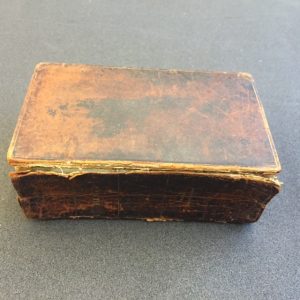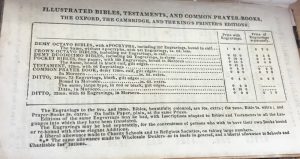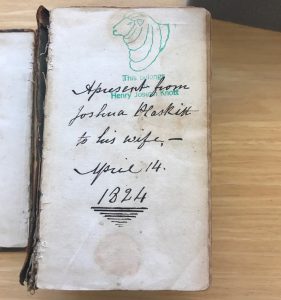
Front Cover and Binding
At Loyola Notre Dame Library, in the collection of rare books, there are many bibles that have long histories. One of those bibles is the Plaskitt Bible. Before I go into the history of the family that owned the book, I want to talk about its physical attributes. This bible has a dark brown leather cover and binding with worn away gold gilding on the outside edges of the cover. The cover is falling off while “Bible with Engravings” is written on the binding. Before even opening the book itself, we know that there will be pictures on the inside. Was this popular at the time? Was it a main selling point of bibles or was it a rare occurrence? The pages inside the book are thin white paper pages, similar to the bibles we more commonly see today. There is no fore edge painting on the pages but instead, when the book is closed, we see that it was gold that has mostly worn away. Was this a cheaper alternative? Or were fore edge paintings not popular at this time? Was the focus on the engravings on the inside of the book rather than hidden ones? The bible with engravings was probably easier to produce than a bible with fore edge paintings but it still maintains the aesthetic appeal that could have attracted buyers. The size of this bible is small and portable and seems very well used, although this damage could be because of its age and the way it was stored rather than use. In the back there is a list of engravings and where to find them and other “useful religious publications” on the last page of the book.  This bible is falling apart and must be missing some of the pages at the beginning that list the publication information and the title. There is, however, a letter to King James at the beginning. This lets us know that this is an edition of the King James Bible. The King James Bible is the authorized edition of the bible that was sanctioned by King James as the official English version to be printed. The letter to King James is not the only thing that we can find at the beginning of this bible. This bible also has a handwritten note on the first page of the book that reads “A present from Joshua Plaskitt to his wife, – April 14, 1824”. On the same page, there is also a stamp with a sheep that says, “This belongs to Henry Joseph Knott”.
This bible is falling apart and must be missing some of the pages at the beginning that list the publication information and the title. There is, however, a letter to King James at the beginning. This lets us know that this is an edition of the King James Bible. The King James Bible is the authorized edition of the bible that was sanctioned by King James as the official English version to be printed. The letter to King James is not the only thing that we can find at the beginning of this bible. This bible also has a handwritten note on the first page of the book that reads “A present from Joshua Plaskitt to his wife, – April 14, 1824”. On the same page, there is also a stamp with a sheep that says, “This belongs to Henry Joseph Knott”.
This bible has a history related to the Plaskitt family. When I was initially examining this particular bible, Anna was kind enough to send me the history of the Plaskitt family that was researched last year by her volunteer Cynthia Requardt. This information states “PLASKITT FAMILY LIBRARY”.
One of the collections donated by the Knotts was the library of the Plaskitt family who lived in Baltimore County, MD. John Plaskitt (1794-1867) was a printer-bookseller (Armstrong & Plaskitt) before retiring. Many of the books belonged to a younger generation and include religious and juvenile literature and school books from the mid-19th century.”. From the small amount of research that I have done on this topic, I found on ancestry.com that Joshua Plaskitt (1831-?) was the son of John Plaskitt (1797- 1867) and Catharine Ann Amoss (1809- 1885). It looks like they had 10 kids together who, besides Joshua, are named Eliza Jane (1836-?), Ann Brooks (1838-1854), William Brooks (1842-1848) Elizabeth Raven (1847-?) Thomas (1832-?), Catharine Ann (1837- 1838), John (1841-1842), Margaret Worthington (1844-?), and finally Sarah Bell (1849- 1875). The names of the children of John Plaskitt and his wife might not be important in the long run, but since this is my first blog post, I wanted to make sure that I have all the basics so that I could quickly find and reference it when I find more information about the family. I hope to learn the name of Joshua Plaskitt’s wife since this is her bible. In my next post, I hope to learn more about the history of the bible and its significance in that time period